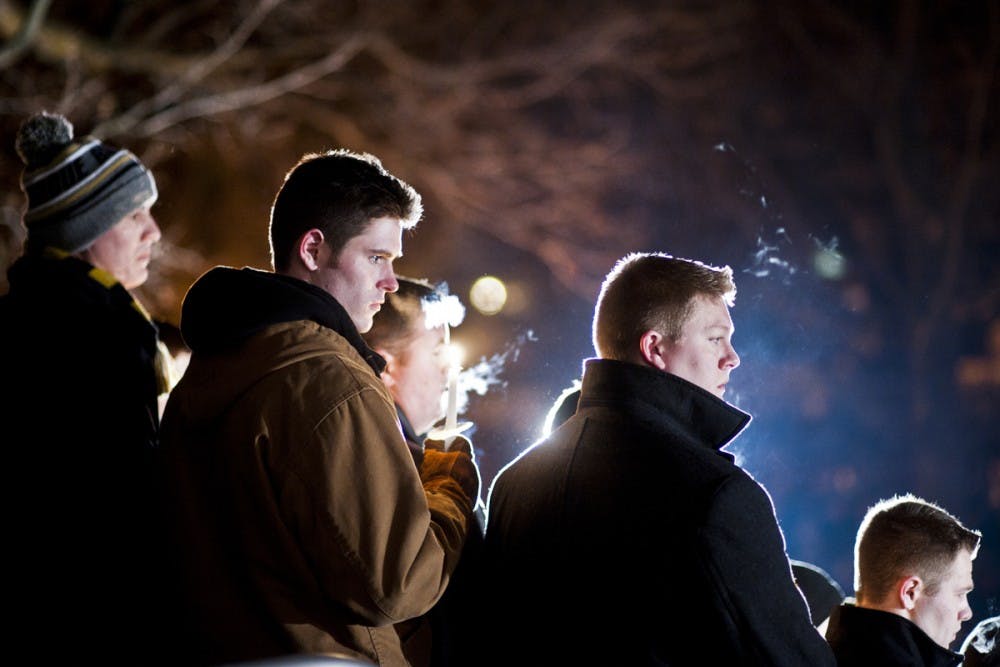HOW THE DAY UNFOLDED:
12:03 p.m. Purdue University police receive calls reporting anywhere from three to five shots being fired inside of the Electrical Engineering Building.
Minutes later Police say suspect Cody Cousins shot Andrew Boldt and left the classroom, room 067. Cousins then leaves the classroom and exits the building from the east door. Cousins surrenders to police, but did not cooperate initially.
2 p.m. Purdue is taken off lockdown.
*2:30 p.m. * The university resumes normal operations. At a press conference, university staff inform the media that one suspect is in custody and one person is dead.
6 p.m. At a second press conference, Purdue officials release the name of both the suspect and victim, after informing Boldt’s family of his death.
Statton Geary was in a classroom near Tuesday’s fatal shooting on the Purdue University campus.
The junior was prepared to fight if he had to — if the gunman entered his classroom.
“My thought was … if he came in, maybe I could grab him,” Geary said. “In my head I said, ‘I’m not going to die today.’”
He was in the Mechanical Engineering Building when sirens sounded. Students checking their phones got word from emergency texts of a shooting in the building next door, the Electrical Engineering Building.
His professor turned off the lights and everyone moved away from the windows and doors. Geary, instead, placed himself right next to one of the entrances.
“I’m at Purdue University,” he recalled thinking. “I’ve given some stuff up to get here, I’m not going to die today.”
Although Geary didn’t know it at the time, one person died from the shooting, and police arrested Cody Cousins, the alleged gunman, after he left the Electrical Engineering Building.
But in the tense moments during which the nation’s attention focused on Purdue and the shooting next door, Geary and his classmates braced for the worst — an active shooter who might come for them next.
So Geary hid by the door, figuring that he might be hurt if he jumped the shooter, but he could at least have a chance to stop an attack.
“My hands were sweating,” he said.
He thought of his parents, pulled out his phone and let them know he was OK.
“I said, ‘I love you,’ just in case,” he said. They were calm.
In the room, meanwhile, other students listened to police scanners on their laptops.
Finally, the sitting and waiting came to an end. Authorities determined that the threat was over, and students in Geary’s building were allowed to leave. It took a while, but around 4 p.m., the university decided to cancel all further classes for Tuesday and today.
The student who died was Andrew Boldt, a senior electrical engineering major from Wisconsin, according to his LinkedIn account.
Students at Purdue planned a candlelight vigil in his honor.
“I think this vigil will be the beginning of a healing process, but I think it will take a while,” Purdue Provost Tim Sands said at a press conference.
Abby Schneller, a sophomore women’s, gender and sexual studies major at Purdue, sang with the Purduettes at the vigil.
“There were candles as far out as I could see,” she said.
The group sang “Songbird” and “My Life is in Your Hands.” Everyone standing together was a unifying experience after a scary day, Schneller said.
“It was just kind of surreal and weird that this happened,” she said. “You just never think this is going to happen on your campus.”
AN EVIDENT TREND
Purdue’s emergency follows a Ball State gun scare in November at the Student Recreation and Wellness Center.
Though someone heard a male voice yell “gun,” police found neither a weapon nor a suspect.
Recently in New Mexico, a 12-year-old opened fire on his classmates and injured two Jan. 14, according to The Associated Press. And Friday in Philadelphia, a 17-year-old shot two of his high school peers when they were in the gym.
Rich Hogue, Indiana school safety liaison with the Indiana State Police, said the publicity and notoriety in shooting incidents tend to breed more incidents.
For example, he noted how Adam Lanza went on a shooting rampage at Sandy Hook Elementary School in Connecticut in December 2012.
“[Lanza] was very well organized and had a flow chart of school shootings,” Hogue said. “So he had followed the things that had happened and he very methodically had planned on, I believe, breaking the record. This is the tragedy.”
Hogue helps school officials and police across the state to provide threat assessment training and an active shooter program for K-12 public and private schools. He focuses on prevention, rather than reactionary measures.
“Almost always, when we look back and start picking, examining what actually happened … somebody knew,” he said. “Whether it’s another student, whether it’s the parents, whether it’s law enforcement.”
Their approach uses threat assessment teams made up of different people in the school community who can focus on communicating with people who might be having problems.
He also teaches the “run, hide, fight” method for an active shooter situation.
“Teachers and law enforcement are willing to die for their students, but what we are trying to convey to them in our sessions is we want them to live for their students,” Hogue said. “We want to provide them with options.”
For Geary, his first instinct was fight.
Although he thought it was a good idea for classes to be canceled Tuesday and today, he said he would be return to campus. He will just be more cautious now.
“I’m going to consider where I’m sitting [and] avoid doors,” he said.
Sam Hoyt and Christopher Stephens contributed to this story.





